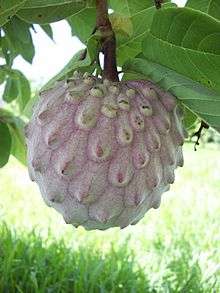Ilama (fruit)
The ilama or ilama tree (Annona diversifolia) is a tropical fruit tree found in Central America. The name is derived from the Nahuatl ilamatzapotl, of which the rough translation is "old woman's sapote". The name is also applied to a similar fruit, soncoya or cabeza de negro (Annona purpurea).
| Ilama | |
|---|---|
 | |
| Scientific classification | |
| Kingdom: | Plantae |
| Clade: | Tracheophytes |
| Clade: | Angiosperms |
| Clade: | Magnoliids |
| Order: | Magnoliales |
| Family: | Annonaceae |
| Genus: | Annona |
| Species: | A. diversifolia |
| Binomial name | |
| Annona diversifolia | |
The ilama fruit is eaten halved, by scooping the flesh out of the rind, and usually chilled when served. It is sometimes served with cream and sugar to intensify the flavor, or with a drop of lime or lemon juice to highlight a tart and bitter note.
The ilama is probably the finest annonaceous fruit which can be grown in the tropical lowlands and the ilama may be termed the cherimoya of the lowlands. [1]
Fruit

The ilama has a compound fruit, which is either cone-shaped, heart-shaped, or ovular. Resembling the cherimoya, it is about six inches (15 cm) long and may weigh as much as two pounds (900 g). Generally, the ilama is covered with more-or-less pronounced, triangular lobules, though some fruits on the same tree may vary from bumpy to fairly smooth.
There are two types of ilama, green and pink. The green type has a flesh that is white and sweet, while the pink type has rosy-colored flesh with a tart taste.
The rind, or skin, of the ilama varies from a pale-green color to a deep-pink or purplish color, coated with a thick layer of velvety, gray-white bloom. It is about 1/4 inch thick (6 mm), leathery, fairly soft, with a grainy surface.
The flesh towards the fruit's center is somewhat fibrous, but smooth and custardy near the rind. The flesh varies from being dryish to being fairly juicy, and contains 25 to 80 hard, smooth, brown, cylindrical seeds, about 3/4 inch (2 cm) long, and 3/8 inch (1 cm) wide. Each seed is enclosed in a close-fitting membrane that, when split, allows the seed to slip out.
Tree
The tree which produces the ilama stands erect at about 25 feet (7.5m), often branching at ground level. It is distinguished by its aromatic, pale-brownish-grey, furrowed bark and glossy, thin, elliptic to obovate or oblanceolate leaves, two to six inches (5–15 cm) long. Clasping the base of the flowering branchlets are one or two leaf-like, nearly circular, glabrous bracts, about 1 to 1-3/8 inches (2.5 - 3.5 cm) in length. New growth is tinged a reddish or coppery color. The solitary flowers have three minutely hairy, long and narrow petals, maroon in color, with small, rusty, hairy sepals, and stamen-like, pollen-bearing inner petals.
Cultivation
Fruit harvest of the ilama tree occurs in late June in Mexico, and only lasts about two weeks. In Guatemala, the harvest season extends from late July to September, and from July to December where the ilama is cultivated in Florida.
According to tradition, the fruits are not to be picked until cracking occurs, but they can be picked a little earlier and held up to three days for softening to take place. If the ilama is picked too early, it will never ripen. The yield of the ilama is typically low. During the normal fruiting period, some trees will have no fruits; others only three to 10, while exceptional trees may bear as many as 85 to 100 fruits per season.
History
Francisco Hernandez was one of the first people to document the ilama. He was sent by King Philip II of Spain in 1570 to take note of the useful products of Mexico. For many years, people confused it with the soursop or the custard apple.
The ilama is native and grows wild in the foothills of the southwest coast of Mexico and of the Pacific coast of Guatemala and El Salvador. It is strictly a tropical plant. It does not grow naturally higher than 2,000 feet (610 m) in Mexico; although in El Salvador it is cultivated at 5,000 feet (1,524 m), and in Guatemala, it is cultivated up to 5,900 feet (1,800 m). The ilama survives best in climates where there is a long dry season followed by plentiful rainfall.[2] The tree is irrigated in areas where rainfall does not fall periodically.
Nutrition
According to analyses made in El Salvador, the food value per 100 g of edible portion of the fruit is as follows:
Trivia
The ilama fruit was used as a plot device in the 1997 Malayalam film Guru,[3][4] directed by Rajeev Anchal. This was India's official entry to the 1997 Academy Award, to be considered for nomination for the Best Foreign Film.[5]
Unlike its portrayal in the film, eating ilama fruit does not cause blindness, nor does the seed cure one of blindness.
References
- Davidson, Alan. Oxford Companion to Food (1999). "Ilama", pp. 395–396.
- Popenoe, Wilson (1920). "The Annonaceous Fruits: The ilama". Manual of tropical and subtropical fruits excluding the banana, coconut, pineapple, citrus fruits, olive, and fig. New York: The MacMillan Company. p. 188-191.
- Ibar, Leandro (1979). Aguacate, chirimoyo, mango, papaya. Barcelona: Editorial Aedos. p. 123. ISBN 9788470032851.
- "GURU - MALAYALAM MOVIE - Review, Trailer, Movie, Actress, Wallpapers, Aam Aadmi Learns The Parable Of ilama Fruit :-)". MouthShut.com. Retrieved 2014-02-10.
- "Archived copy". Archived from the original on 2013-02-10. Retrieved 2012-12-18.CS1 maint: archived copy as title (link)
- "Archived copy". Archived from the original on November 21, 2012. Retrieved December 18, 2012.CS1 maint: archived copy as title (link)